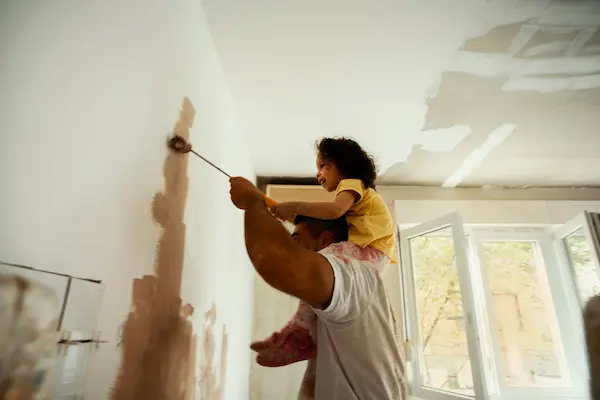Should you let your tenants make improvements? It’s really up to you.

As a property manager and landlord, one of the more challenging questions you may face is whether or not to let your tenants make improvements to your rental. If your rental house is a bit older or your tenants just want to express their own personal style, a tenant may come to you and ask to make changes to the walls, flooring, light fixtures, or landscaping, among others. Responding to these requests is challenging not only because every situation is different, but also because there are both pros and cons to letting tenants do work themselves. But with careful consideration and some good preparation, you can make the choice that is right for you.
First, it’s important to have a clear understanding of the difference between repairs and improvements. Repairs are usually one-time fixes for problems that arise while the tenant has possession of the property. These may include things like plumbing leaks, broken door hinges, malfunctioning appliances, and so on. Anything that would have a negative effect on the home’s habitability is the landlord’s responsibility to repair.
An improvement, on the other hand, is something that either extends the life of your property or increases its value. Common property improvements include interior and exterior painting, replacing worn or outdated flooring, replacing light fixtures, faucets, or cabinets, or adding new landscaping elements. Improvements are typically changes made to update the style or functionality of a property, and so are not covered by most habitability laws.
If a tenant asks to make an improvement, one of the first things to consider before agreeing to anything is whether it will make your rental more or less attractive to future renters. Although your rental may be occupied now, tenant turnover is a fact of owning a rental property. To that end, you need to be careful to maintain the property’s appeal for not just your current tenant, but for future tenants as well. If the requested changes are extreme or following a short-lived interior design trend, it’s better to just say no. On the other hand, if your tenant wants to upgrade your countertops or flooring, and you approve of the materials they are planning to use, you may stand to benefit from those changes and feel more inclined to say yes.
Another important element to consider when tenants ask to make changes to the property is who will pay for it. You may assume that if the tenant asks to make an upgrade that they will also pay for the materials to do so. But that is not always the case. A savvy tenant may understand that the improvements they want to make will add value to the property and ask you to help cover the costs. In some situations, especially if your tenant has verifiable construction skills, it might be worth agreeing to do so. On the other hand, shoddy workmanship is always a risk, and may actually cause your property to lose value.
One of the best ways to anticipate tenant requests to make improvements is to have a set of criteria and lease documents ready ahead of time. There are three important clauses that you can include in your standard lease that will clearly define your policy on tenant improvements. First, it’s a good idea to include a clause that requires your tenant to pay for any improvements you make for them by request. This would include only improvements above and beyond keeping the property in habitable condition. Second, be sure to include a clause in your lease that clearly explains that approved improvements, no matter who makes them, become part of the rental property and are surrendered by the tenant when they move out. Finally, you should include a clause that explains what the process is should the tenant make changes to the property that result in damage or devaluation. Usually, this entails requiring the tenant to return the property to its original condition or paying to have it restored.
Should your tenant make unauthorized changes to the property, your lease should also clearly explain what the consequences are. If you find out your tenant has made improvements without your permission, you should first document it immediately and then notify your tenants that it is a violation of their lease. This is true even if you like the changes they made. If that is the case, you could simply explain that you will not pay for the cost of the improvements since they were made without approval. But if you don’t like the changes, you’ll need to insist that they restore the property back to the way it was when they first move in. If the tenant is unable or unwilling to do so, you could either deduct the cost of the restoration from their security deposit or, if the deposit doesn’t cover it, consider evicting them and taking them to court for the cost of repairs.
Every property needs improvements now and then, and it doesn’t hurt to listen to your tenant’s suggestions. If your tenant has good ideas, it may even help your property values increase! Still, every situation and every tenant are different, so it may be a choice you make on a case-by-case basis. Still, once you are confident that everyone clearly understands the potential gains and risks, the final decision is entirely up to you.
We are pledged to the letter and spirit of U.S. policy for the achievement of equal housing opportunity throughout the Nation. See Equal Housing Opportunity Statement for more information.
Get the Neighborly App
In addition to Real Property Management's expert skills in managing your rental property, you can utilize Neighborly's other brands to maintain and enhance your home. Use the Neighborly App to get connected to local home service professionals. Download and receive offers only available on the App.
Depending on current health and safety regulations in your area, some of the services mentioned in this post may not be available. Neighborly service providers will follow the latest health and safety guidelines provided by the local and state governments. Please check with your local Neighborly service provider for details at the time you need service(s).






